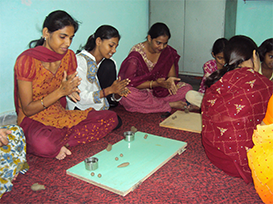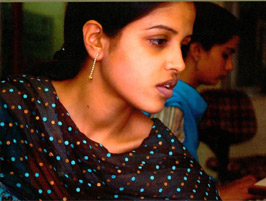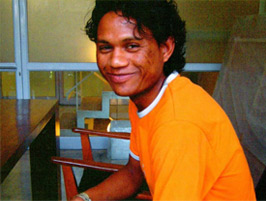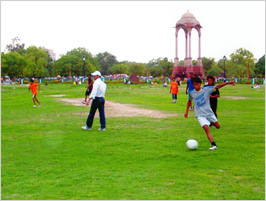 Youthreach works with children who face the disadvantage of limited exposure to the creative arts. We believe art is not only a great source of healing but also of enabling the children to find the latent artist within. We engage with renowned artistes who volunteer to open up for our children new vistas in the creative and performing arts – dance, music, pottery, theatre, sculpting, photography, puppetry, baking, cooking and more, so that they may acquire or hone a skill. Taking on an apprentice, the artist, too, gets to place his or her art in a different context. Such interaction has tremendous possibility of developing a skill in a child which may later translate into a vocation. Over the years, Youthreach has reached out to over 1000 children through its different programmes.
Youthreach works with children who face the disadvantage of limited exposure to the creative arts. We believe art is not only a great source of healing but also of enabling the children to find the latent artist within. We engage with renowned artistes who volunteer to open up for our children new vistas in the creative and performing arts – dance, music, pottery, theatre, sculpting, photography, puppetry, baking, cooking and more, so that they may acquire or hone a skill. Taking on an apprentice, the artist, too, gets to place his or her art in a different context. Such interaction has tremendous possibility of developing a skill in a child which may later translate into a vocation. Over the years, Youthreach has reached out to over 1000 children through its different programmes.
The programme AIMS primarily to:
- Engage highly creative people from civil society to apprentice children in art
- Expose children to a creative skill
- Provide appreciation of art and culture to the children
- Expose the artist to a different world
- Enhance the probability of employment and sale
Youthreach has facilitated apprenticeship programmes in art, craft, self-defence, hospitality, IT, beauty and make-up, and similar spaces.
- Eminent potters such as Vijay Pal have taught children from the Salaam Baalak Trust and Very Special Arts to work on the creator’s wheel to make earthen lamps, beads, paperweights and animals.
- Eight girls from Udayam Prayas are being trained in Bharatanatyam at the Yamini Krishnamurthy School of Dance by Yamini Krishnamurthy. The training includes ritual initiation into the dance and performances by the girls.
- Firoz Haider, Director, India Dance Theatre, has trained children from Dhriti in contemporary dance. Shiamak Davar’s Victory Arts Foundation has trained 25 children from Sshrishti in western dance.
- Jindal Academy for Photographic Excellence has conducted photography workshops for disadvantaged children. The workshop, spread over 15 sessions, has impacted 30 students from four NGOs over the past few years.
- Eminent artist Damyanti Sharma trained 30 children from Ank and Vidya & Child and organised two art exhibitions ‘Warriors of Light’ at the Ashoka Hotel, where the children showcased and sold their work alongside other renowned artists.
- In tandem with the Martial Arts Association, Youthreach has facilitated self-defence workshops for our partner NGOs such as Aman Biradari in teaching young girls to defend themselves against bullying, eve teasing and molestation.
- Vinnie Mathur conducted ‘Best of out of Waste’ glass painting workshop with 10 children from Udayam Prayas at the India Habitat Centre.
Some inspiring stories of the lives of some young people whose lives have been impacted and touched by Youthreach programmes
 Bus Number 620
Bus Number 620
MEENAKSHI lives with her family in Daryaganj, Delhi. At 26 years of age she has rich life experiences to share. She graduated from Delhi University in 2003. However, she has been working as an office assistant since 2001.Realising how crucial computer knowledge was, she enrolled herself in basic computers at NAB Delhi, a project facilitated by Youthreach and supported by Alcatel Lucent Foundation and International Youth Foundation. On May1st ’08, she joined NAB Delhi as Project Coordinator, whereby she supports core programmes at NAB, by collecting and compiling data. This has given her an opportunity to learn about the development sector which she wants to cultivate further. Meenakshi wishes to pursue her Masters in Social Work.
ITO! ITO! ITO!’- A loud thumping sound of a hand hitting the side of the bus. Screeching brakes and the bus comes to a halt. Shuffling, scrambling feet added to the tremor caused by the approach of the bus, and people rushed and pushed to board it. There was no order, just several hands that pushed and negotiated their way, bodies jostled and the end result was a cloud of dust. People who had been successful in bullying others with their ‘might and power’ made it on board and the bus shrieked its departure. Some made last minute valiant efforts in chasing it as far and fast as their feet would allow them to. The dust settled down, so did the aggression and people slipped into silence as they waited for the next bus.It was then that you noticed the quiet presence of a young girl, amidst the chaos. With a flick of her index finger, Meenakshi pushed a strand of hair behind the ear and confidently approached a man, maybe in his forties, almost double her age. “Excuse me, when the 620 comes, please tell me.” “Sure,” the man replied“Initially I used to be afraid of asking people. What would they think? Due to this fear, I would go close to the bus, in an attempt to read the number. On most such occasions, I would miss the bus. In the past, I was scared of traveling by bus. See it takes me almost an hour to reach office and I can’t afford to miss my bus.
So I explained to myself, “agar sharam karoongi toh apna hi nuksaan hoga.” (If I hesitate, it will be my loss only).At 9.45 am, Meenakshi reached her office. A flight of steps alongside a ramp, both led to a room in the basement, Meenakshi’s work place. At first glance, it looked like any other office – a row of tables and chairs,arranged in an L-shape, each with a computer, notice boards and scattered tea cups, fresh tea stains on some tables, indicative of the urgency of work, and of course there were people, busy in conversation. As Meenakshi entered the room, a mechanical drone in varied speeds of diction could be heard from the computers, ‘PRINT, CONTROL C, WELCOME MEENAKSHI, MY DOCUMENTS, TCS, PROJECT’ each letter being said out aloud. ‘A’ from one end, ‘MY’ from another, ‘C DRIVE,’ called another corner, as people busily punched their keyboards. That buzz was a peep into another reality and Meenakshi, as if confirming this,gently explained, “In today’s times it is through computers and technology that we can achieve everything.‘JAWS’ is computer software, which provides a voice to a computer and thus supports so many people with visual impairment. This has added so much value to my life. This advancement in technology has helped in mainstreaming us. We always had some skills, which were better than others, in some regard; but today technology has enabled us to contribute our skills and thus move towards independence.”“Meenakshi!” breezed in a shrill voice of a colleague. “The prospectuses have arrived.” “Ok, thank you. I have to pay Rs. 200, right?” Although she was cross checking much before the reply, she had already started collecting the money from two different purses. Then with a smile she explained, “I keep two purses, just incase one gets stolen; at least I will have money in the other one.” She was interrupted by a phone call.
“Good afternoon sir,” she said in a soft voice. “Sir, you will find it in the cupboard next to the main door, in the last drawer. Yes, I am fine, thank you.” After hanging up with a coy look she said, “It is not that I am praising myself, but I have a good memory. Till date, my boss from my previous job calls up to inquire about certain papers. I can recall without much difficulty, and I am usually right too,” she added with a radiant smile.
“I feel I am good at managing things and that’s what my core ability is, which further strengthens my work. As a project coordinator here, my job is to gather information on various projects and collate it for further work to be done by respective teams handling the project. Once I understand what is expected of me, I usually don’t take too much time and can manage with minimum resources. Currently I am handling three projects, where my main work is to interact with people, either for organising their interviews, or for taking feedback of users of our helpline, processing this information, tabulating it and sending it to the teams handling the implementation. This helps them evaluate their work or plan the next step. I also ensure that I am able to spend some time or stay back after work hours to catch up on other IT related training that happen on this campus. This helps me in honing my skills.”
As if suddenly caught up with a past trail of thoughts silence followed her breath for sometime. After a few minutes, she snapped out of it and said, “I have learnt some crucial lessons. It is very important to have a supportive environment. If you have that, everything else is possible and manageable. I have some plans for the future. I will pursue my studies further. There is growing scope in the NGO sector and I want to do my MSW (Masters in Social Work). Par usse pehle abhi toh bahut mehnat karni hai.” (But before that I have to work very hard). “After reaching home I practice on my PC. Classes only teach you theory and work sometimes limits you to a few aspects of the computer, but at home I can practice everything.” Her long, but active day came to an end and it was time to go home. Back at the bus stop her voice suddenly faded into the din of voices and the screeching brakes of the bus – the 620. “Madam, your bus has come,”an elderly gentleman called out to her. A haze of dust started to dance around, through which she made her way to the front door of the bus, boarded it safely, then turned around to wave and the last of her words were heard, overpowering the noise of the crowd around her, “Ummeed kabhi nahin chhorni chahiye.” (We should never let go of hope) she said, drowning the noise of the crowd around her.
 PAINT MY WORLD
PAINT MY WORLD
VISHNU came to Delhi at a very young age and got associated with Salam Baalak Trust (SBT). He trained in puppetry and drawings at SBT and completed his 10th grade through SBT. Through Youthreach’s Arts and Apprenticeship promotion initiative he got in touch with a well known Graphic designer, Vivek Sahni and has been working with him for the past two years.
It’s a quiet locality without much intrusion. The building is small but attractive with huge glass doors opening at both sides welcoming you with a warm embrace. On the ground floor there is some construction work going on while going upstairs to the first floor one can hear chaotic sounds typical of any workplace especially towards the end of the day. There are people scurrying about here and there, running up and down. There are a few others who are talking on the phone; faces emanating expressions of colour and meaning. Amidst this chaos is a young man of about 21 years, quietly looking completely self possessed, unruffled by the tumult around, intently gazing at his computer screen. There is an unmistakable calmness around Vishnu; he is drawing a sketch on the screen with great degree of aplomb. “Vishnu, someone has come to see you”, a voice breaking his concentration draws his attention; it is one of his colleagues who has been watching him work for some time. With an absent looking smile on his face Vishnu gets up.
Vishnu has been working with a well known graphic designer, Vivek Sahni for the past two years. Art is his forte and cards, measurement scales, pieces of paper in different colours, shapes and sizes; the whole paraphernalia lying all over his desk is a testimony to this fact. “Painting ka bachpan se hi shauk tha, main kitab mein se dekhkar aur centre par jo sikhate the, usse sikhta tha, drawing karta tha” (I was interested in drawing since childhood. I used to learn how to sketch from sketch books and from whatever I was taught at my learning centre). Vishnu with a beaming smile on his face recalls his first day at work as if it were just the other day. He talks in reverence and very fondly of Sam, his senior colleague, his mentor, who he calls his Guru. The latter has contributed a lot to his learning. “I got lots of ideas from him; he taught me how to make bags, envelopes and boxes.” Vishnu handles one of the most critical and challenging stages of designing cards – the artwork. By far his most challenging assignment has been that of a wedding card where he drew some sketches that were liked by everyone.
The self-assuredness with which Vishnu talks, is markedly unnoticed. There are many layers of him not quite apparent but palpable waiting to be fathomed. In the continuum of life, one lives through varied experiences. Actions of childhood many a time may hold no meaning but they do affect one’s direction in life. Vishnu calls himself a deviant child with an air of nonchalance. “Mujhe bachpan mein padhai se nafrat thi. slate aur pencil tod ke school se bhag aata tha” (I used to hate studying, used to destroy my slate and pencils and run away from school). At a very young age of 8, he left his home and went to Mumbai with his friends. He was there in Mumbai for a year doing menial jobs when his family traced him and his brother brought him back to Delhi. “I used to see children in their uniforms going to schools, and felt ashamed that I was wasting my time”. He then came in contact with an NGO called SBT (Salaam Baalak Trust), where Vishnu learnt to draw. His love for artwork landed him at Vivek Sahni’s office.
Vishnu at this young age carries himself with a certain degree of maturity. Like a seasoned person with plenty of experience he talks about his work, about his ideas, views and knowledge with confidence. Like any other diligent and persevering person, Vishnu knows the mantra of success in life by heart. “Jo bhi karna hai ek hi cheez karo man se, fir safalta zaroor milti hai” (Whatever you want to do, do one thing at a time with devotion; success will embrace you).
The pandemonium in the room has subsided now and people are wrapping up their work quietly to call it a day. Vishnu also has to shut his computer and wind up his work. Browsing through folders on his computer screen, he inadvertently smiles as if something has struck him. Pointing to the names of his folders, he blurts out the word ‘Karate’. All the folders are invariably bearing the name Karate with some prefix or suffix. Learning and teaching Karate is his passion, says he, with childlike excitement. He has also learnt puppetry at SBT. Vishnu has expressed a desire to put everything that he has learnt in the course of life to some use. He admits that he is a great cook and loves the food business; is seriously mulling over starting a restaurant with some of his friends. This young man is simply a bundle of simmering yet calm energy, in constant exploration; straddling different facets of his own self and life at large with ease and simplicity.
 SHOOTING STARS
SHOOTING STARS
RAJU THAPA left home for the city of Delhi at the age of 12 in hope of a better future. Ever since, he has been with Salaam Baalak Trust. He is now in 11th Grade and was in 8th Grade when he started playing soccer at India Youth Soccer Association under the guidance of Mr. Arup Das as a part of Youthreach’s Soccer Programme. Raju Thapa wants to one day join a club and make it big in the field of soccer. He is also a cartoonist but soccer is where his heart lies. RAM KEWAL got lost at the Old Delhi Railway Station while traveling with his parents from Mathura to Ambala. He worked for a while before coming in touch with the Salaam Baalak Trust. His family could never be traced and Now has a foster family. It has been six years at Salaam Baalak Trust and today Ram is in 10th Grade. He started playing at India Youth Soccer Association five years ago and aspires to be a soccer player.
Cristiano Ronaldo dribbles past the first defender. The man’s got magic in his feet. Ronaldo passes the ball over three defenders to Sunil Chettri, who flames it past the goal keeper. What a stunning goal!!!!! Look at the way Ronaldo passes the ball which only needs touching and Chettri slices it home. Magnificent game by both Ronaldo and Chettri!!!!!!!! This is magic…pure magic.
On the lawns of India Gate, a little away from the memorial, boys standing in a line call out “1…..2…..1……2…..1…..” Interestingly many of them are wearing black T-shirts. All the 1s are one team and the 2s other. The problem now being – how do you identify your team members. So, it is decided by the coach who is easily identifiable – by a whistle hanging from the neck, that Team 1 would be the one with black T-shirts on and Team 2 with no colour restraint and hence a colourful team. Subsequently, the boys exchange their T-shirts and get ready to warm up before playing. The two teams start warming-up separately. The goal keepers trying to stop the ball and the rest of the team attempting to make a goal. This goes on for about ten minutes after which the coach, wearing jeans and a white cap as if to go with his white shirt and shoes, blows the whistle and shouts-“line up”. Boys leave practicing and run towards the coach forming a line in a ‘stand at ease’ stance. The coach gives them instructions. Pointing at the many bright-orange cones around them in a circle he says, “These cones mark the boundary of the field and you are not to cross them.” He then points at two cones about four to five meters apart and a little within the boundary to his right and says, “That is the ‘Knight Riders’ (as the Black T-shirt team prefers to be called) goal post” and right opposite, on his left are similar cones which he calls the “Vibrant (colourful) team’s goal post.” There are no captains.
The lawn is patchy, with some areas bald, grassless areas. There is no sunshine but the birds can be heard and seen going back in flocks to their homes. The weather seems pleasant. There are trees around and the Amaltas trees, with their yellow flowers in full bloom add to the natural beauty.
The game of thirty-minutes begins with the kick-off. The ball comes to Ram Kewal, in black T-shirt and red shorts. A little dark in complexion and about 5 feet tall, his striking feature are his bushy eyebrows which meet right above the bridge of his nose. This sober-boy takes the ball past the defenders with an air of seriousness but, reaching close to the goal post, he feels threatened by one of the defenders (a tall, well-built boy) challenging him for the possession of the ball. Ram immediately passes the ball to his team member who dives and with a beautiful header scores the first goal for the Knight Riders. There are two reasons why Ram passed on the ball to his team member – one – he gets intimidated by huge players – “Main lambechaude players se bhidta nahin hoon – dar lagta hai” (I don’t confront players who are tall and big built, I’m scared of them) and two – he truly believes that soccer is not an individual’s game, it is a team that plays together and hence the most important thing is to have faith in your team members- “You should trust your team members.”
The ball is in the possession of the vibrant team. The vibrant team player takes the ball past the defending team and into the penalty area (not demarcated by any lines). One can hear someone screaming – “Pass the ball here, quick pass it here!” Raju Thapa, wearing a grey and blue T-shirt with white shorts and shoes, screams but to no response. Frustrated he says, “Chal bhai tu hi maar le.” (Ok you get this one). The Vibrant team player is then intercepted by the defending team player and the ball goes out of the goal line. The Vibrant team gets a corner kick and this time Raju Thapa, who constantly wears a wonderful smile on his face, is in custody of the ball. He takes the ball into the penalty area, looks at his target and manoeuvres the ball towards it but misses it by only a millimetre. Disgusted with his performance, Thapa lifts his face towards the sky with his eyes and nose crinkled.
Suddenly it starts to get dark and gusts of air blow, dark clouds start to cover the sky and the weather seems to close in. The wind carries with it dust, which makes it difficult to play but undeterred, the boys continue with their game. People around them start to pick up their bags, gather their playing children and move out of the lawns. The boys feel small drops of water on them, but they continue playing, unaffected.
The ball is in Thapa’s control. The ball is trapped between his legs and the defenders are incapable of gaining possession. He manoeuvres the ball beautifully. Brilliant balance, control and dexterity! His calf and thigh muscles flex as he sprints dribbling the ball upto the penalty area. He has penetrated the defence. This time Thapa seems determined to make that crucial goal tin order o be even with the other team. He looks up and steers the ball with precision. A stupefying goal by an exquisite player! This is a trade mark of Cristiano Ronaldorun that ends up in a goal. The ball curves just as Thapa wants it to and it is beautifully hammered home. Thapa cannot believe what he just did. He gives a sigh and runs to his team mates in jubilation. His team mates pat his back and hug him. With a smile cutting across his face and a twinkle in his eyes he says, “I feel very happy when people tell me that I’m a good player. I want to be better and play at the international level. I want to take India ahead in the game of soccer. I want to make a football team in SBT (Salaam Baalak Trust). I don’t know if I will make it big as a player but will surely promote the game.”
It becomes brighter – the (passing) clouds give way to some light. The coach blows the whistle and informs the players that only last two minutes of the game remain. Blood pressure starts to rise and there is this tension in the air. Ram is concentrating on the ball and Thapa is still not out of his jubilation mood, he has a smile on his face and looks as though he is still living the moment. The Knight Riders have the ball. Ram draws the ball and further passes it to his midfielder. Ram moves up a little, draws the ball again and this time again is confronted by the huge player. Ram takes on the challenge but instead of getting past the defender, he tries to score a goal from half-way, a talent in David Beckham he always admired. Ram does not shy from shooting from long range, he takes a quick look at the goal post and steers the ball. Brilliant steer!!! Just when it seemed like the game would end in a draw, Ram comes out with this magnificent shot. Hritesh (from the Vibrant team and Ram’s best friend) and Ram exchange glances and smiles. The Knight Riders run upto Ram to give him a pat on the back and all that Ram does is smile. “I want to be a soccer player, but I know that this is not easy. If not a player, then I want to be a Sports teacher in some hi-fi public school. And I want to play like Aneesh – to be able to dribble the ball past everyone and score a goal like he does.”
The ball is with the Vibrant team when the coach blows the whistle to signal that the time is up. With a smile on his face, the coach tells the losing team not to get disheartened. The team replies that losing is a part of the game and to lose a game against their own team mates is not disheartening.
These boys believe that camaraderie, communication within a team and stamina are few things which make a team successful. They also believe a good coach and mentor is important. “Our coach is very good to us. He is almost like our friend. He is always on the look-out for opportunities for us to play a match with other teams. Arup Das sir of India Youth Soccer Association (who introduced us to the world of soccer) has also helped us as much as he could. He also has certain constraints.”
The boys are just lazing around removing their boots when the weather starts to close in again and this time it starts to drizzle. Everyone hurries collecting the cones, the soccer balls and their bags and walk with their coach towards the bus stand with the anticipation to come back to the lawns in another 3-4 days. The ground which a while ago had this brilliant ambience has suddenly gone dead once the boys leave. A silence falls on the ground as if it were trying to reflect on all it has witnessed.
Ram Kewal aspires to be a player like Sunil Chettri. “My friends tell me that I play like him and I also think the same. I want to play for the country like him.” Raju Thapa wishes to play like Cristiano Ronaldo one day. The similarity in their style of playing is quite apparent – free styling, tackling and dribbling. “I want to learn to dribble the way Ronaldo does and play for my country like him. Today soccer has given me a goal- the goal of my life.”




